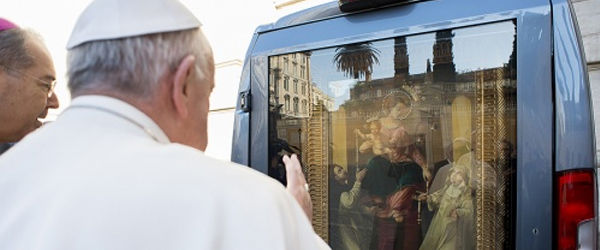Thus, as part of the anniversary festivities planned (including concerts, workshops, prayer services and a youth rally), parishioners at St. Andrew have also put together Art and Architecture walking tours of their church building. The first series of tours held recently drew community members, history buffs and architectural lovers. (More bilingual tours are slated Oct. 1-2.)“It’s such a magnificent building that probably could not be built today and was amazing that it was even built back then,” remarks Ann Jarvis Longyear, long-time parishioner and docent tour guide.Indeed, this Romanesque 1928 church building is a testimony to the beauty of a bygone era when churches were elaborately crafted as much as homage to the past as they were gifts for future generations.Like many parishes in the Los Angeles Archdiocese, St. Andrew’s current church and location wasn’t its first. Established in 1886, the parish had to relocate twice because of growing demands of the bustling city.In 1926, St. Andrew’s fifth pastor, Msgr. John McCarthy, had the task of overseeing the construction of a new church building. Having studied in Rome, he strongly advocated bringing the glories of Roman art and architecture to the burgeoning Pasadena area.Ross Montgomery, a contemporary of such famed local architects as Wallace Neff, Myron Hunt and Reginald Johnson, was chosen to design the new St. Andrew’s (which many consider his masterpiece). And he clearly followed Msgr. McCarthy’s wishes.Standing outside the church, world travelers will notice a striking familiarity of the church exterior. It was modeled after the Basilica of St. Mary in Cosmedin, a sixth century Roman church that features the tallest medieval belfry in the city.The thick and heavy wooden oak doors lead to the entry where, under a canopy arch of cast stone with Corinthian capitals topping the pilaster, ornate frescos and ceiling beams (painted by Venetian artist Bellino Tasco) welcome worshippers. Longyear points out that at one time, the vestibule walls were covered over with wallpaper (“three layers thick, and black, gold and brown — shocking!”) and were painstakingly removed in the 1990s during a massive restoration project that is ongoing.Off to one side, the shimmery baptistery is enclosed in sculpted bronze gates and adorned with colorful images of the evangelists, beatitudes and sacraments with gold leaf accents. The centerpiece is an exquisite marble baptismal font, which, because of the Depression, was not completed until much later. A generous donor, Kenyon Reynolds, was responsible for decorating and furnishing this area that is capped with a dome of golden color and an ornate candelabrum. Entering the spacious church, the eye is drawn heavenward to the decorated wooden beams. Frequent visitors to Rome will immediately see the church’s doppelganger as the Basilica of St. Sabina of the Aventine which, built in 432 A.D., is one of the earliest examples of Christian-style church architecture.Like St. Sabina, St. Andrew’s features 24 columns on either side of the church, colored in salmon, sea foam green, dark lilac, yellow and more, which add warmth and texture. Made of concrete and coated with “scagliola” (pigmented plaster with molded ground marble alabaster or gypsum) these one-of-a-kind columns were produced by Italian immigrant artisans in the church basement and were brought upstairs in four pieces. (Solid marble columns were out of the question not just for the cost but also because building codes changed after the San Francisco Earthquake.) The interior church walls are also of scagliola.Color is also infused in the fabric of the church thanks to the artistry of Italian painter Carlo Wostry, a descendent of Renaissance painters, who was first commissioned to only paint the murals above the altar. When the parishioners saw his work, they raised funds to have him paint the All Saints Chapel and then the stunning Stations of the Cross mural that is found on the center arches. Wostry’s works were done on canvas and then fastened to the walls. The Stations of the Cross murals were painted in Trieste, Italy then shipped to Pasadena. Though the church was dedicated in 1927, it took Wostry eight years to complete the murals, which he later regarded as the “crowning work” of his artistic life.Many other Roman and European touches abound in the church. The Carrera marble altar is identical to sarcophagus of a tomb in Ravenna, Italy; a Michelangelo-inspired Pieta is framed by two ionic columns; and numerous replicas of Italian paintings by Botticelli, Raphael and Da Vinci adorn church walls.The total cost of the church building upon completion was $778,000 — or about $10 million in today’s currency.St. Andrew’s seats about 1,000 people and parishioner Marta Mack says that at most of the seven Sunday Masses “it’s hard to find a seat; we’re packed!” With its wonderful acoustics, the church has been the locale for many musical events, including the annual Bach to Broadway concerts that support the restoration and maintenance of the church tower (this year on Sept. 9).Other music-related events in 2011 include a Gospel Mass on June 12, Mariachi de Sol in concert on July 24, and the Los Angeles Master Chorale on Nov. 6.But whether guests come to St. Andrew’s to pray, visit or hear great music, being inside such a place of stately beauty and quiet grandeur is a spiritually uplifting and awe-inspiring experience, says pastor Father Paul Sustayta.“I don’t think any of our parishioners take for granted this magnificent worshipping space we have here,” he says. But gathering at St. Andrew’s, he adds, is powerful not just because of its breathtaking beauty, but because of the diversity of people who come together: celebrities, political figures, college students, families, rich and poor, Latino, African-American, Filipino and more. “The beauty of the church building is equally matched by the beauty of people of our parish,” says Father Sustayta. “Everyone is welcomed.”St. Andrew Church is at 311 N. Raymond St., Pasadena. Information: (626) 792-4183.{gallery width=100 height=100}gallery/2011/0520/sgandrew/{/gallery}

